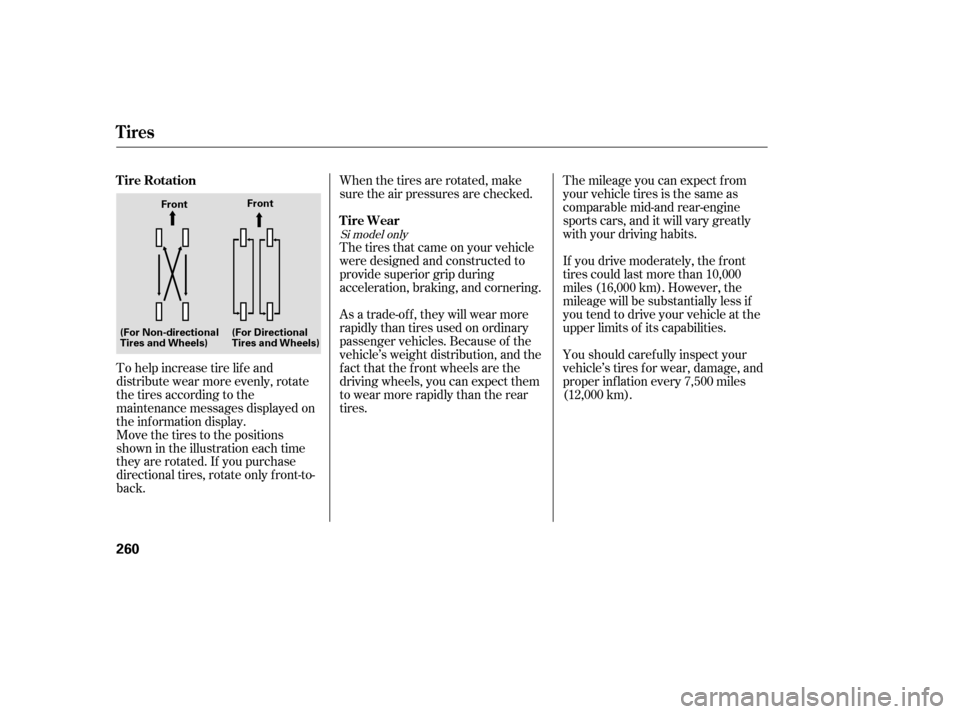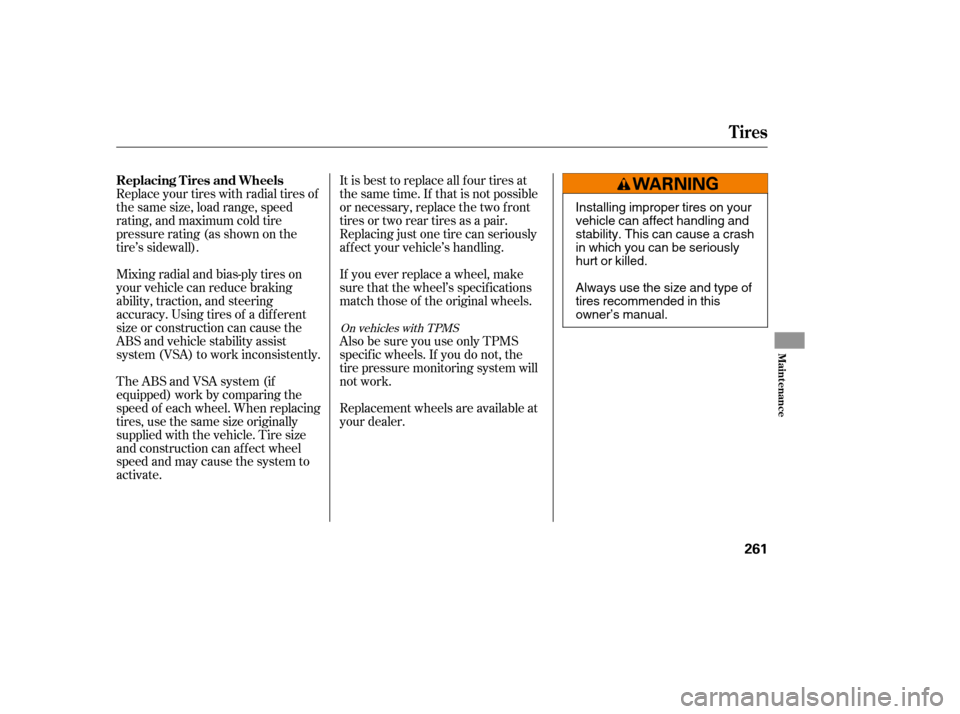Page 226 of 303

To change the driver’s side bulb,
start the engine, turn the steering
wheel all the way to the right, and
turn of f the engine. To change the
passenger’s side bulb, turn the
steering wheel to the lef t. Remove the electrical connectorf rom the bulb by pushing on the
tab to unlock it, then slide the
connector of f the bulb.Remove the bulb f rom the
headlight assembly by turning it
one-quarter turn counterclockwise.
Insert the new bulb into the hole,
and turn it one-quarter turn
clockwise to lock it in place.
Push the electrical connector back
onto the bulb. Make sure it is on
all the way.
Turn on the headlights to test the
new bulb.
Use a Phillips-head screwdriver to
remove the screw from the inner
f ender, and pull the inner f ender
cover back. Reinstall the inner f ender cover.
Then reinstall the screw and
tighten it securely.
2.
1.
3.4. 5.6.7. 8.
Lights
L ow Beam Headlight
248
SCREW
BULB
ELECTRICAL CONNECTOR
�����—�����—�
�
�y�
�������������y���
�(�+���������y���������y
Page 227 of 303

Remove the bulb f rom the socket
by pushing the bulb in and turning
it counterclockwise until it unlocks.
Install the new bulb in the socket.
Turn it clockwise to lock it in place.
Insert the socket back into the
headlight assembly. Turn it
clockwise to lock it in place.
Turn on the lights to make sure
the new bulb is working.
Remove the socket from the
headlight assembly by turning it
one-quarter turn counterclockwise.
To change the driver’s side bulb,
start the engine, turn the steering
wheel all the way to the right, and
turn of f the engine. To change the
passenger’s side bulb, turn the
steering wheel to the lef t.
Use a Phillips-head screwdriver to
remove the screw from the inner
f ender, and pull the inner f ender
cover back.
Reinstall the inner f ender cover.
Then reinstall the screw and
tighten it securely.
4. 5. 6. 7. 8.
3.
2.
1.
Lights
Replacing the Front Side Marker/
Parking/Turn Signal Light Bulb
Maint enance
249
�����—�����—�
�
�y�
�������������y���
�(�+���������y���������y
Page 240 of 303
The last f our digits of the TIN (tire
identif ication number) are f ound on
the sidewall of the tire and indicate
the date of manufacture (Seeon page ). In addition to proper inf lation,
correct wheel alignment helps to
decrease tire wear. If you f ind a tire
is worn unevenly, have your dealer
check the wheel alignment.
Have your dealer check the tires if
you f eel a consistent vibration while
driving. A tire should always be
rebalanced if it is removed f rom the
wheel. When you have new tires
installed, make sure they are
balanced. This increases riding
comf ort and tire lif e. For best results,
have the installer perform a dynamic
balance.
301
For vehicles equipped with aluminum
wheels:
Tire
Labeling T ire Maintenance
Tires
259
Improper wheel weights can damage
your vehicle’s aluminum wheels. Use
only Honda wheel weights f or
balancing.
�����—�����—�
�
�y�
�������������y���
�(�+���������y���������y
Page 241 of 303

To help increase tire lif e and
distribute wear more evenly, rotate
the tires according to the
maintenance messages displayed on
the information display.
Move the tires to the positions
shown in the illustration each time
they are rotated. If you purchase
directional tires, rotate only f ront-to-
back.Themileageyoucanexpectfrom
yourvehicletiresisthesameas
comparable mid-and rear-engine
sports cars, and it will vary greatly
with your driving habits.
If you drive moderately, the f ront
tires could last more than 10,000
miles (16,000 km). However, the
mileage will be substantially less if
you tend to drive your vehicle at the
upper limits of its capabilities.
You should caref ully inspect your
vehicle’s tires f or wear, damage, and
proper inf lation every 7,500 miles
(12,000 km).
As a trade-of f , they will wear more
rapidly than tires used on ordinary
passenger vehicles. Because of the
vehicle’s weight distribution, and the
fact that the front wheels are the
driving wheels, you can expect them
to wear more rapidly than the rear
tires.
The tires that came on your vehicle
were designed and constructed to
provide superior grip during
acceleration, braking, and cornering.
When the tires are rotated, make
sure the air pressures are checked.
Si model only
Tires
Tire Rotation
Tire Wear
260
FrontFront
(For Non-directional
Tires and Wheels) (For Directional
Tires and Wheels)
�����—�����—�
�
�y�
�������������y���
�(�+���������y���������y
Page 242 of 303

Replace your tires with radial tires of
the same size, load range, speed
rating, and maximum cold tire
pressure rating (as shown on the
tire’s sidewall).
Mixing radial and bias-ply tires on
your vehicle can reduce braking
ability, traction, and steering
accuracy. Using tires of a dif f erent
size or construction can cause the
ABS and vehicle stability assist
system (VSA) to work inconsistently.
The ABS and VSA system (if
equipped) work by comparing the
speed of each wheel. When replacing
tires, use the same size originally
supplied with the vehicle. Tire size
and construction can affect wheel
speed and may cause the system to
activate.It is best to replace all f our tires at
thesametime.If thatisnotpossible
or necessary, replace the two f ront
tires or two rear tires as a pair.
Replacing just one tire can seriously
af f ect your vehicle’s handling.
If you ever replace a wheel, make
sure that the wheel’s specif ications
match those of the original wheels.
Also be sure you use only TPMS
specif ic wheels. If you do not, the
tire pressure monitoring system will
not work.
Replacement wheels are available at
your dealer.
On vehicles with TPMS
Tires
Replacing T ires and Wheels
Maint enance
261
Installing improper tires on your
vehicle can affect handling and
stability. This can cause a crash
in which you can be seriously
hurt or killed.
Always use the size and type of
tires recommended in this
owner’s manual.
�����—�����—�
�
�y�
�������������y���
�(�+���������y���������y
Page 243 of 303

�´
Tires marked ‘‘M S’’ or ‘‘All
Season’’ on the sidewall have an all-
weather tread design suitable for
most winter driving conditions.
For the best perf ormance in snowy
or icy conditions, you should install
snow tires or tire chains. They may
be required by local laws under
certain conditions.
Wheels:
Tires:
If your vehicle is equipped with
summer tires, be aware that these
tires are not designed f or winter
driving conditions. For more
inf ormation, consult your dealer.
See page f or inf ormation about
DOT Tire Quality Grading, and page f or tire size and labeling
inf ormation.
DX and Canadian DX-G Si
Si
LX, EX, EX-L
LX, EX, EX-L
DX and Canadian DX-G with
automatic transmission
Canadian DX-G with manual
transmission
301 299
Optional Si model only
Tires
Winter Driving
Wheel and T ire Specif ications
Summer T ires
262
15x6J
16x61/2J
17x7J P195/65R15 89H
215/45ZR17 91W
P215/45R17 87V
P205/55R16 89H
P195/65R15 89S
(all season tire)
(summer tire)
�����—�
���—�����y�
�������������y���
�(�+���������y���������y
Page 244 of 303

Mount tire chains on your tires when
required by driving conditions or
local laws. Install them only on the
f ront tires.
If you mount snow tires on your
vehicle, make sure they are radial
tires of the same size and load range
as original tires. Mount snow tires on
all f our wheels. The traction
provided by snow tires on dry roads
maybelowerthanyouroriginaltires.
Check with the tire dealer f or
maximum speed recommendations. When installing chains, f ollow the
manuf acturer’s instructions, and
mount them as tight as you can.
Make sure they are not contacting
the brake lines or suspension. Drive
slowly with them installed. If you
hear them coming into contact with
the body or chassis, stop and
investigate. Remove them as soon as
youbegindrivingonclearedroads.Because your vehicle has limited tire
clearance, Honda strongly
recommends using the chains listed
below, made by Security Chain
Company (SCC).
Cable-type: SCC Radial Chain
CONT INUED
Tires
T ire Chains
Snow T ires
Maint enance
263
CH2311T
�����—�����—�
�
�y�
���������
���y���
�(�+���������y���������y
Page 245 of 303
Clean the wheels as you would the
rest of the exterior. Wash them with
thesamesolution,andrinsethem
thoroughly.
Aluminum alloy wheels have a
protective clear-coat that keeps the
aluminum f rom corroding and
tarnishing. Cleaning the wheels with
harsh chemicals (including some
commercial wheel cleaners) or a stif f
brush can damage the clear-coat. To
clean the wheels, use a mild
detergent and a sof t brush or sponge.
If equipped
Wheels
Tires
264
Using the wrong chains, or not
properly installing chains, can
damage the brake lines and
cause a crash in which you can
be seriously injured or killed.
Follow all instructions in this
owner’s manual regarding the
selection and use of tire chains.
Traction devices that are the wrong
size or improperly installed can
damage your vehicle’s brake lines,
suspension, body, and wheels. Stop
driving if they are hitting any part of
the vehicle.
�����—�����—�
�
�y�
���������
���y���
�(�+���������y���������y